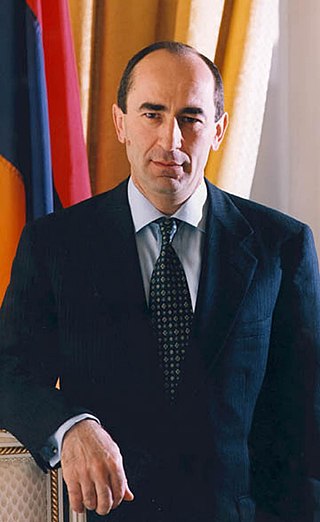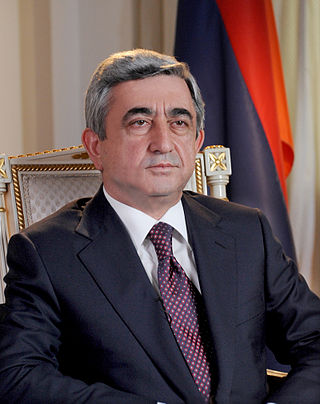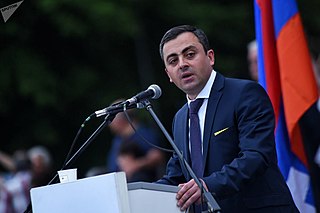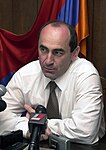
The politics of Armenia take place in the framework of the parliamentary representative democratic republic of Armenia, whereby the president of Armenia is the head of state and the prime minister of Armenia the head of government, and of a multi-party system. Executive power is exercised by the president and the Government. Legislative power is vested in both the Government and Parliament.

The history of Armenia covers the topics related to the history of the Republic of Armenia, as well as the Armenian people, the Armenian language, and the regions of Eurasia historically and geographically considered Armenian.

Vazgen Zaveni Sargsyan was an Armenian military commander and politician. He was the first Defence Minister of Armenia from 1991 to 1992 and then from 1995 to 1999. He served as Armenia's Prime Minister from 11 June 1999 until his assassination on 27 October of that year. He rose to prominence during the mass movement for the unification of Nagorno-Karabakh with Armenia in the late 1980s and led Armenian volunteer groups during the early clashes with Azerbaijani forces. Appointed defence minister by President Levon Ter-Petrosyan soon after Armenia's independence from the Soviet Union in late 1991, Sargsyan became the most prominent commander of Armenian forces during the First Nagorno-Karabakh War. In different positions, he regulated the military operations in the war area until 1994, when a ceasefire was reached ending the war with Armenian forces controlling almost all of Nagorno-Karabakh and seven surrounding districts.

Robert Sedraki Kocharyan is an Armenian politician. He served as the President of the Nagorno-Karabakh Republic from 1994 to 1997 and Prime Minister of Nagorno-Karabakh from 1992 to 1994. He served as the second President of Armenia between 1998 and 2008 and as Prime Minister of Armenia from 1997 to 1998.

Levon Hakobi Ter-Petrosyan, also known by his initials LTP, is an Armenian politician and historian who served as the first president of Armenia from 1991 until his resignation in 1998.

Karen Serobi Demirchyan was a Soviet and Armenian politician. He served as the First Secretary of the Communist Party of Armenia from 1974 to 1988. Soon after his reemergence into active politics in independent Armenia in the late 1990s, he became President of the National Assembly in 1999 until his assassination with other politicians in parliament in the Armenian parliament shooting.

Human rights in Armenia tend to be better than those in most former Soviet republics and have drawn closer to acceptable standards, especially economically. Still, there are several considerable problems.

Armen Vardani Sarkissian is an Armenian politician, physicist and computer scientist who served as the 4th president of Armenia from 9 April 2018 to 1 February 2022. He served as Prime Minister of Armenia from 4 November 1996 to 20 March 1997 and was the country's longest-serving ambassador to the United Kingdom from 1998 to 2018. Sarkissian was elected on 2 March 2018 and assumed the presidency on 9 April 2018. He resigned on 23 January 2022. Sarkissian gave a reason for his resignation saying that the country’s constitution does not give the president sufficient powers to influence events.

The 1999Armenian parliament shooting, commonly known in Armenia as October 27, was a terrorist attack on the Armenian National Assembly in the capital of Yerevan on 27 October 1999 by a group of five armed men led by Nairi Hunanyan that, among others, killed the two de facto decision-makers in the country's political leadership—Prime Minister Vazgen Sargsyan and Parliament Speaker Karen Demirchyan. Their reform-minded coalition had won a majority in a parliamentary election held in May of that year and had practically sidelined President Robert Kocharyan from the political scene.
Presidential elections were held in Armenia on 19 February 2008. Prime Minister Serzh Sargsyan was elected in the first round according to official results, but this was disputed by former President Levon Ter-Petrosyan, who was officially placed second.

A constitutional referendum was held in Armenia on 27 November 2005. The referendum was on a series of changes to the constitution of Armenia which were backed by the international community. The official results had a high turnout and overwhelming support for the changes. However the opposition and election monitors said that there were serious irregularities with the referendum.
Presidential elections were held in Armenia on 16 March 1998, with a second round on 30 March. The result was a victory for independent candidate Robert Kocharyan, who won 58.9% of the vote in the second round. Turnout was 63.5% in the first round and 68.1% in the second.

Parliamentary elections were held in Armenia on 6 May 2012. President Serzh Sargsyan's ruling Republican Party gained more majority of the parliament seats. Armenia's wealthiest man Gagik Tsarukyan's Prosperous Armenia came second with about one fourth of the seats, while ANC, ARF, Rule of Law and Heritage won less than 10 percent each.

Presidential elections were held in Armenia on 18 February 2013. In the run-up to the elections, Armenia's first President Levon Ter-Petrosyan and Gagik Tsarukyan, leader of the second largest parliamentary party Prosperous Armenia, withdrew from the race in December 2012. Many believed that no candidate would be able to challenge incumbent President Serzh Sargsyan, others stated that people see "absence of alternatives" and these factors caused great apathy among the public.
A series of mass protests were held in Armenia following the 2003 presidential election, led by the former presidential candidate Stepan Demirchyan.

Presidential elections were held in Uzbekistan on 29 March 2015. The result was a victory for incumbent President Islam Karimov, who received over 90% of the vote. Karimov's win gave him a fourth consecutive term as president, dating back to 1990.
The following lists events that happened in 2008 in Armenia.

Snap parliamentary elections were held in Armenia on 20 June 2021. The elections had initially been scheduled for 9 December 2023, but were called earlier due to a political crisis following the 2020 Nagorno-Karabakh War and an alleged attempted coup in February 2021.

Ishkhan Vachiki Saghatelyan is an Armenian politician who from August 6, 2021 till July 2, 2022, served as deputy speaker the National Assembly of Armenia. He is the current chair of the Supreme Council of Armenia of the Armenian Revolutionary Federation (ARF). He served as the governor of Gegharkunik province from June 1, 2018, until October 3, 2018. Saghatelyan was the lead coordinator of the Homeland Salvation Movement, which led protests calling for the resignation of Prime Minister Nikol Pashinyan after the end of the 2020 Nagorno-Karabakh war.

The 2022 Armenian protests were a series of anti-government protests in Armenia that started on 5 April 2022. The protests continued into June 2022, and many protesters were detained by police in Yerevan. Protestors demanded Prime Minister of Armenia Nikol Pashinyan resign over his handling of the 2020 Nagorno-Karabakh war. On 14 June 2022, the opposition announced their decision to terminate daily demonstrations aimed at toppling Prime Minister Nikol Pashinyan after failing to achieve popular support.















